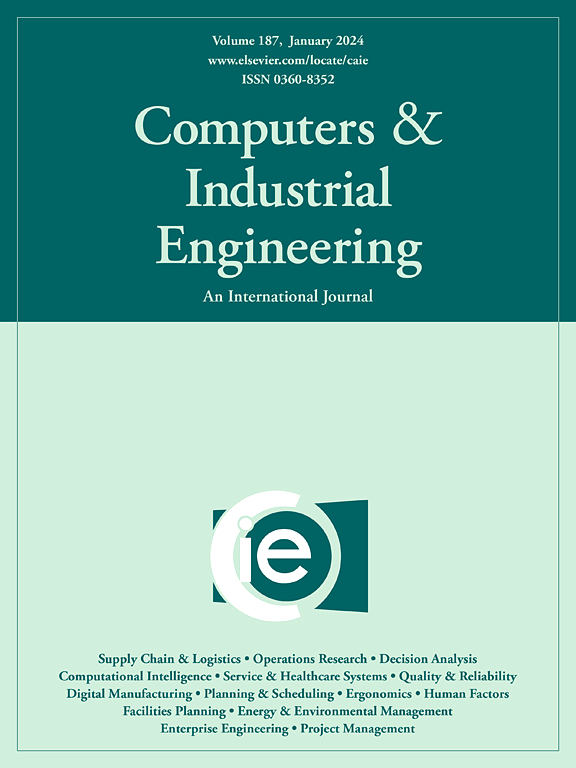Construction of a new robust dual-channel supply chain network with forward logistics and reverse logistics
IF 6.7
1区 工程技术
Q1 COMPUTER SCIENCE, INTERDISCIPLINARY APPLICATIONS
引用次数: 0
Abstract
Dual-channel closed-loop supply chain (CLSC) is a new supply chain model that integrates the offline and online sales channels into a CLSC. Dual-channel CLSC involves more echelons, which often leads to uncertainty in the dual-channel CLSC design. Although some studies have focused on uncertain dual-channel CLSC designs, there are still research gaps in the existing literature, such as a lack of robust models, inefficiencies in existing designs, and limited attention to certain industries. To fill these research gaps, we examine the design of the CLSC network based on partially known distribution information about uncertain transportation costs and demand. We construct a moment ambiguity set for uncertain costs and a bounded unimodal ambiguity set for uncertain demand. Using these ambiguity sets, we develop a new distributionally robust optimization (DRO) model with ambiguous chance constraints (ACCs) for the dual-channel CLSC design problem, which can be reformulated as a computationally tractable mixed-integer linear programming (MILP) model. To enhance solving efficiency, we build an accelerated Benders decomposition (BD) algorithm for the MILP model. A case study on BYD automotive illustrates the effectiveness of our developed approach. The computational results demonstrate that our proposed model withstands uncertainties in transportation costs and demand with a probability of 95%, establishing a dual-channel CLSC network that balances robustness and cost-effectiveness, resulting in a total cost reduction of approximately 14% compared to the deterministic model. Additionally, the sensitivity analysis reveal that the adjustment of the ACC tolerance level, the proportion of online and offline sales, and the handling methods of products significantly influence BYD Auto.
构建稳健的正向物流与逆向物流双通道新型供应链网络
双渠道闭环供应链(CLSC)是一种将线下和线上销售渠道整合为一个CLSC的新型供应链模式。双通道CLSC涉及更多的梯队,这往往导致双通道CLSC设计中的不确定性。虽然一些研究集中在不确定的双通道CLSC设计上,但现有文献中仍然存在研究空白,例如缺乏鲁棒模型,现有设计效率低下,以及对某些行业的关注有限。为了填补这些研究空白,我们研究了基于不确定运输成本和需求的部分已知分布信息的CLSC网络设计。我们构造了一个不确定成本的矩模糊集和一个不确定需求的有界单峰模糊集。利用这些模糊集,我们建立了一个新的具有模糊机会约束的双通道CLSC设计问题的分布鲁棒优化(DRO)模型,该模型可以重新表述为计算可处理的混合整数线性规划(MILP)模型。为了提高求解效率,我们针对MILP模型建立了一种加速Benders分解算法。比亚迪汽车的一个案例研究说明了我们开发的方法的有效性。计算结果表明,我们提出的模型以95%的概率承受运输成本和需求的不确定性,建立了一个平衡鲁棒性和成本效益的双通道CLSC网络,与确定性模型相比,总成本降低了约14%。此外,敏感性分析显示,ACC容差水平的调整、线上线下销售比例、产品处理方式对比亚迪汽车的影响显著。
本文章由计算机程序翻译,如有差异,请以英文原文为准。
求助全文
约1分钟内获得全文
求助全文
来源期刊

Computers & Industrial Engineering
工程技术-工程:工业
CiteScore
12.70
自引率
12.70%
发文量
794
审稿时长
10.6 months
期刊介绍:
Computers & Industrial Engineering (CAIE) is dedicated to researchers, educators, and practitioners in industrial engineering and related fields. Pioneering the integration of computers in research, education, and practice, industrial engineering has evolved to make computers and electronic communication integral to its domain. CAIE publishes original contributions focusing on the development of novel computerized methodologies to address industrial engineering problems. It also highlights the applications of these methodologies to issues within the broader industrial engineering and associated communities. The journal actively encourages submissions that push the boundaries of fundamental theories and concepts in industrial engineering techniques.
 求助内容:
求助内容: 应助结果提醒方式:
应助结果提醒方式:


